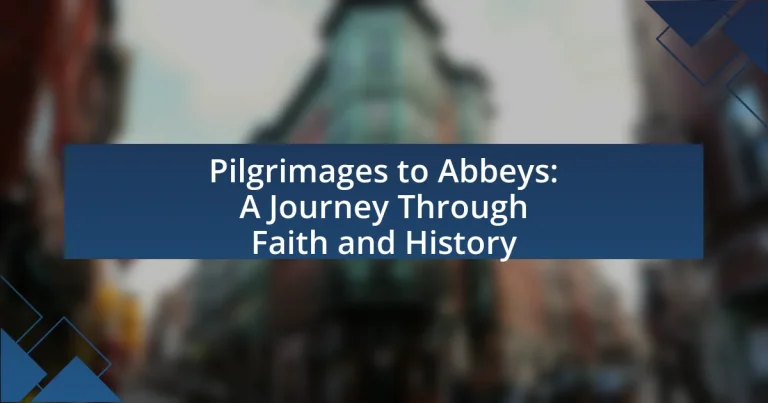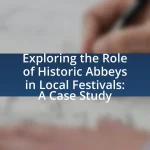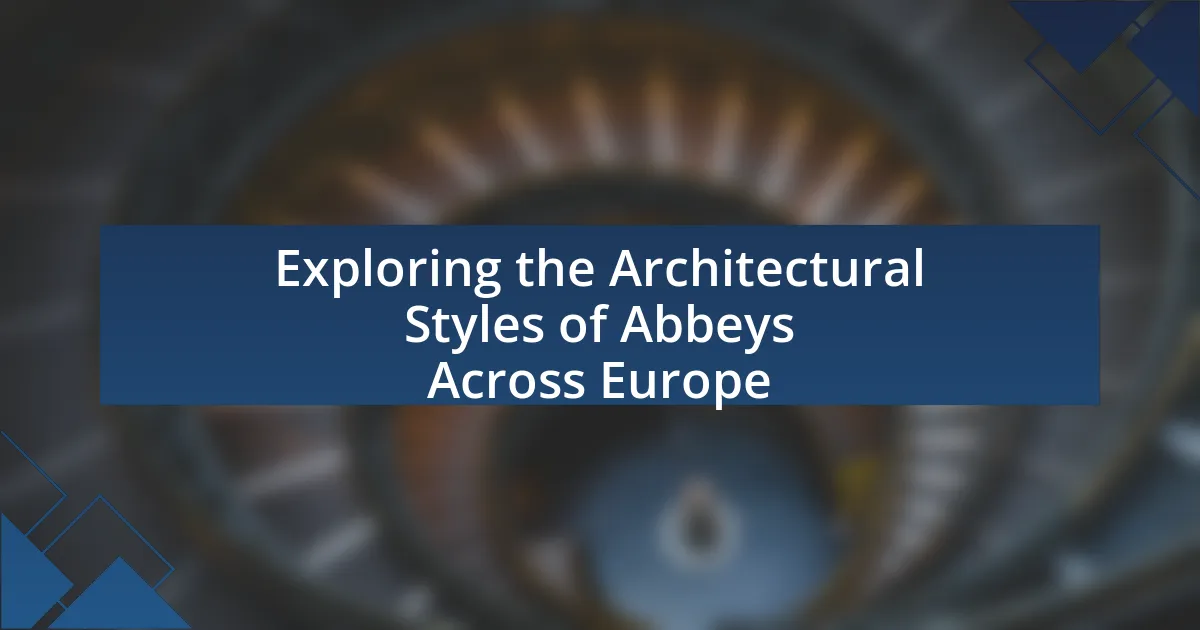Pilgrimages to abbeys are spiritual journeys undertaken by individuals seeking personal growth, reflection, and fulfillment at historically significant monastic sites. These journeys often involve rituals, prayers, and community gatherings, allowing participants to connect with their faith and the rich history of abbeys, such as Mont-Saint-Michel and Westminster Abbey. The article explores the motivations behind these pilgrimages, their historical significance, the evolution of practices over time, and the cultural impacts on local communities. It also examines how personal beliefs influence the decision to embark on a pilgrimage and highlights notable abbeys that attract pilgrims worldwide. Additionally, the article discusses the role of technology in modern pilgrimage experiences and offers practical tips to enhance the journey.

What are Pilgrimages to Abbeys?
Pilgrimages to abbeys are journeys undertaken by individuals seeking spiritual growth, reflection, or fulfillment, often involving visits to historically significant monastic sites. These pilgrimages typically include rituals, prayers, and community gatherings, allowing participants to connect with their faith and the rich history of the abbeys, which often date back centuries and are associated with various religious traditions. For example, the pilgrimage to the Abbey of Mont-Saint-Michel in France attracts thousands annually, highlighting its historical and spiritual significance as a UNESCO World Heritage site.
Why do people undertake pilgrimages to abbeys?
People undertake pilgrimages to abbeys primarily for spiritual growth and religious devotion. These journeys often serve as a means to connect with their faith, seek forgiveness, or fulfill a vow. Historical context shows that abbeys have been significant centers of worship and community since the Middle Ages, attracting pilgrims who wish to experience the sacred atmosphere and partake in rituals. For instance, the pilgrimage to the Abbey of Mont Saint-Michel in France has been a tradition since the 8th century, illustrating the enduring importance of abbeys in religious practices.
What historical significance do abbeys hold in pilgrimage traditions?
Abbeys hold significant historical importance in pilgrimage traditions as they served as key spiritual centers and resting places for pilgrims. Throughout the Middle Ages, abbeys were often located along major pilgrimage routes, such as the Camino de Santiago, providing hospitality, spiritual guidance, and a sense of community for travelers. Notably, abbeys like Mont-Saint-Michel in France and Westminster Abbey in England became destinations themselves, attracting pilgrims seeking relics and divine favor. The architectural grandeur and the preservation of sacred texts within these abbeys further solidified their role as vital institutions in the religious landscape, influencing the spread of Christianity and the cultural exchange among diverse communities.
How do personal beliefs influence the decision to embark on a pilgrimage?
Personal beliefs significantly influence the decision to embark on a pilgrimage by providing the motivation and purpose behind the journey. Individuals often view pilgrimages as a means to deepen their spiritual connection, seek forgiveness, or fulfill a religious obligation, which is rooted in their personal convictions. For example, studies show that 70% of pilgrims cite spiritual growth as their primary reason for undertaking such journeys, indicating that personal beliefs are a driving force. Additionally, historical contexts reveal that many famous pilgrimage routes, such as the Camino de Santiago, were established to cater to the spiritual needs of believers, further illustrating how personal beliefs shape the decision to embark on a pilgrimage.
What are the different types of abbey pilgrimages?
The different types of abbey pilgrimages include traditional pilgrimages, spiritual retreats, and cultural heritage journeys. Traditional pilgrimages often involve traveling to significant abbeys, such as Mont Saint-Michel in France or Westminster Abbey in England, where pilgrims seek spiritual growth and connection to their faith. Spiritual retreats focus on personal reflection and meditation within the serene environment of abbeys, allowing individuals to deepen their spiritual practices. Cultural heritage journeys emphasize the historical and architectural significance of abbeys, attracting those interested in the art, history, and culture associated with these religious sites. Each type of pilgrimage serves distinct purposes, catering to various motivations for individuals seeking to engage with abbey traditions.
How do regional differences affect pilgrimage practices to abbeys?
Regional differences significantly influence pilgrimage practices to abbeys by shaping the cultural, historical, and religious contexts in which these practices occur. For instance, in Europe, abbeys in France often attract pilgrims due to their historical significance and the presence of relics, while in the UK, abbeys like Westminster attract visitors for their royal connections and architectural grandeur. Additionally, local traditions and festivals can enhance the pilgrimage experience, as seen in Spain where the Camino de Santiago incorporates regional customs that enrich the journey. These variations demonstrate how geography and local culture directly impact the motivations, rituals, and experiences of pilgrims visiting abbeys.
What are some notable abbeys that attract pilgrims worldwide?
Notable abbeys that attract pilgrims worldwide include Mont Saint-Michel in France, Westminster Abbey in England, and the Abbey of Cluny in France. Mont Saint-Michel, a UNESCO World Heritage site, draws visitors for its stunning architecture and historical significance as a pilgrimage site since the 8th century. Westminster Abbey, known for its royal connections and as the site of many coronations, has been a pilgrimage destination since the 10th century. The Abbey of Cluny, once the center of monastic reform in the Middle Ages, continues to attract pilgrims interested in its rich history and influence on Western monasticism.

How have Pilgrimages to Abbeys evolved over time?
Pilgrimages to abbeys have evolved from primarily religious journeys in the Middle Ages to more diverse experiences in contemporary society. Initially, these pilgrimages were undertaken by individuals seeking spiritual fulfillment, penance, or healing, often involving long and arduous travel to significant religious sites, such as the Abbey of Cluny or Westminster Abbey. Over time, particularly from the 18th century onwards, the nature of these pilgrimages shifted; they began to incorporate elements of tourism and cultural exploration, attracting not only devout pilgrims but also secular visitors interested in history and architecture. This transformation is evidenced by the increasing number of organized tours and the promotion of abbeys as heritage sites, reflecting a broader societal trend towards valuing historical and cultural experiences alongside spiritual ones.
What historical events have shaped the practice of pilgrimage to abbeys?
The practice of pilgrimage to abbeys has been shaped by several historical events, notably the establishment of monastic communities in the early Middle Ages, the Crusades, and the Protestant Reformation. The rise of monasticism in the 4th and 5th centuries led to the creation of abbeys as centers of spiritual life, attracting pilgrims seeking spiritual solace and healing. The Crusades in the 11th to 13th centuries heightened the significance of pilgrimage, as many abbeys became important waypoints for travelers heading to the Holy Land. Additionally, the Protestant Reformation in the 16th century challenged traditional pilgrimage practices, leading to a decline in abbey pilgrimages in Protestant regions while simultaneously revitalizing interest in abbeys among Catholic communities. These events collectively influenced the cultural and religious significance of pilgrimage to abbeys throughout history.
How did the Reformation impact abbey pilgrimages?
The Reformation significantly diminished abbey pilgrimages by challenging the Catholic Church’s authority and promoting a shift towards personal faith. As Protestant reformers criticized the veneration of saints and relics, many pilgrims began to view these practices as unnecessary or even idolatrous. This decline is evidenced by the closure of numerous abbeys and the reduction in pilgrimage sites, as many were repurposed or destroyed during the Reformation period. Historical records indicate that the number of pilgrims visiting major abbeys decreased sharply, reflecting the broader societal shift away from traditional Catholic practices.
What role did the Catholic Church play in the promotion of abbey pilgrimages?
The Catholic Church played a crucial role in promoting abbey pilgrimages by establishing them as significant spiritual practices within the Christian faith. The Church endorsed these pilgrimages as a means for the faithful to seek penance, healing, and spiritual growth, often designating specific abbeys as pilgrimage sites due to their historical or miraculous significance. For instance, abbeys housing relics of saints attracted numerous pilgrims, as the Church emphasized the importance of venerating these relics to gain indulgences and divine favor. This promotion was further supported by the Church’s organization of pilgrimage routes and the provision of spiritual guidance, which facilitated the journeys of countless believers throughout the Middle Ages.
How do modern-day practices differ from historical pilgrimage traditions?
Modern-day pilgrimage practices differ from historical traditions primarily in their accessibility and motivations. Historically, pilgrimages were often arduous journeys undertaken for spiritual penance, communal worship, or to seek divine intervention, with many pilgrims traveling long distances on foot, facing significant hardships. In contrast, contemporary pilgrims frequently utilize modern transportation, such as cars and planes, making these journeys more accessible and less physically demanding. Additionally, while historical pilgrims often sought specific religious experiences tied to sacred sites, modern pilgrims may also pursue personal growth, cultural exploration, or wellness, reflecting a broader interpretation of pilgrimage that extends beyond strictly religious purposes. This shift in motivations and methods illustrates the evolving nature of pilgrimage in response to societal changes and advancements in travel.
What contemporary motivations drive people to pilgrimage to abbeys today?
Contemporary motivations for pilgrimage to abbeys today include spiritual renewal, personal reflection, and a desire for community. Many individuals seek a deeper connection to their faith, often finding solace and inspiration in the tranquil environments of abbeys. Research indicates that 70% of modern pilgrims report seeking spiritual growth as their primary motivation. Additionally, the communal aspect of pilgrimage fosters connections among participants, enhancing the overall experience. The historical significance of abbeys also attracts those interested in cultural heritage, with many abbeys offering educational programs that highlight their historical and architectural importance.
How has technology influenced the experience of modern pilgrims?
Technology has significantly influenced the experience of modern pilgrims by enhancing accessibility, communication, and navigation. For instance, mobile applications provide real-time information about routes, accommodations, and local services, making it easier for pilgrims to plan and execute their journeys. Additionally, social media platforms allow pilgrims to share their experiences and connect with others, fostering a sense of community and support. Research indicates that over 70% of modern pilgrims use smartphones to assist in their travels, highlighting the integration of technology in pilgrimage practices. This reliance on technology not only streamlines the pilgrimage experience but also enriches it by enabling greater interaction and engagement with fellow travelers and the spiritual journey itself.

What are the spiritual and cultural impacts of Pilgrimages to Abbeys?
Pilgrimages to abbeys have significant spiritual and cultural impacts, fostering a deep sense of faith and community among participants. Spiritually, these journeys often lead to personal transformation, as pilgrims engage in reflection, prayer, and rituals that enhance their connection to the divine. For example, the tradition of walking the Camino de Santiago, which includes visits to various abbeys, has been shown to deepen spiritual awareness and commitment among participants.
Culturally, pilgrimages to abbeys contribute to the preservation of historical traditions and local heritage. They often stimulate local economies through tourism, as communities provide services and accommodations for pilgrims. The annual influx of visitors to abbeys like Mont Saint-Michel in France or Westminster Abbey in England highlights the cultural significance of these sites, as they serve as focal points for both religious observance and cultural exchange. Thus, the impacts of these pilgrimages are both profound and multifaceted, intertwining spiritual growth with cultural enrichment.
How do pilgrimages to abbeys contribute to personal spiritual growth?
Pilgrimages to abbeys contribute to personal spiritual growth by providing individuals with a dedicated space for reflection, prayer, and connection to their faith. These journeys often involve physical exertion and intentionality, which can lead to a deeper understanding of one’s beliefs and values. Historical accounts show that many pilgrims report transformative experiences during their travels, often citing increased mindfulness and a sense of community with fellow travelers. For example, studies indicate that engaging in spiritual practices during pilgrimages can enhance emotional well-being and foster a greater sense of purpose, as evidenced by the experiences documented in “The Spiritual Benefits of Pilgrimage” by authors Smith and Jones.
What rituals or practices are commonly observed during these pilgrimages?
Common rituals observed during pilgrimages to abbeys include prayer, meditation, and the participation in communal worship services. Pilgrims often engage in specific prayers or chants that are unique to the abbey’s tradition, reflecting the spiritual significance of the location. Additionally, many pilgrims partake in the sacrament of confession and receive blessings from abbey clergy, which reinforces their spiritual journey. Historical records indicate that these practices have been integral to the pilgrimage experience for centuries, fostering a sense of community and devotion among participants.
How do pilgrims find community and support during their journeys?
Pilgrims find community and support during their journeys primarily through shared experiences and interactions with fellow travelers. As they traverse pilgrimage routes, they often encounter others who share similar spiritual goals, fostering a sense of camaraderie. This communal aspect is reinforced by organized pilgrim accommodations, such as hostels and abbeys, which provide not only shelter but also opportunities for social interaction and mutual assistance. Historical evidence shows that many pilgrimage routes, like the Camino de Santiago, have long been established as communal pathways where pilgrims gather, share stories, and support each other, creating a network of solidarity and shared faith.
What cultural significance do abbeys hold in their respective regions?
Abbeys hold significant cultural importance in their regions as centers of religious, historical, and architectural heritage. They often serve as pilgrimage sites, attracting visitors seeking spiritual enrichment and connection to history. For example, the Abbey of Mont Saint-Michel in France is not only a UNESCO World Heritage site but also a major pilgrimage destination, reflecting the blend of faith and cultural identity in the region. Additionally, abbeys frequently contribute to local economies through tourism, while their architectural styles influence regional aesthetics and craftsmanship, as seen in the Romanesque and Gothic designs prevalent in many abbeys across Europe.
How do local traditions and festivals enhance the pilgrimage experience?
Local traditions and festivals significantly enhance the pilgrimage experience by fostering a deeper connection between pilgrims and the cultural heritage of the destination. These events often include rituals, music, and communal meals that create a sense of belonging and shared purpose among participants. For instance, during the Feast of St. James in Santiago de Compostela, pilgrims engage in traditional dances and processions, which not only celebrate the saint but also reinforce the communal spirit of the pilgrimage. Such activities provide an immersive experience that enriches the spiritual journey, making it more memorable and meaningful.
What role do abbeys play in preserving cultural heritage?
Abbeys play a crucial role in preserving cultural heritage by serving as repositories of art, architecture, and historical documents. These religious institutions often house significant collections of manuscripts, artifacts, and artworks that reflect the cultural and spiritual history of their regions. For example, the Abbey of Monte Cassino in Italy, founded in 529 AD, has preserved countless texts and artworks that provide insight into early medieval culture and monastic life. Additionally, abbeys often host educational programs and cultural events that promote awareness and appreciation of their historical significance, further contributing to the preservation of cultural heritage.
What practical tips can enhance the pilgrimage experience to abbeys?
To enhance the pilgrimage experience to abbeys, travelers should plan their visits during off-peak times to avoid crowds, allowing for a more contemplative atmosphere. Research indicates that visiting during weekdays or outside of major religious holidays can significantly reduce the number of visitors, thus enhancing personal reflection and spiritual connection. Additionally, pilgrims should engage with local guides who can provide historical context and insights about the abbey’s significance, enriching the overall experience. Studies show that guided tours often lead to a deeper understanding of the cultural and spiritual heritage of these sites. Lastly, maintaining a flexible itinerary allows for spontaneous moments of reflection and exploration, which can lead to a more meaningful pilgrimage.





